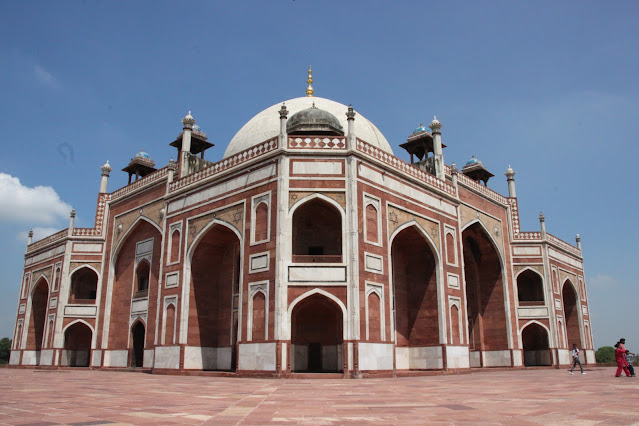India Chronicles: Humayun’s Tomb - poetry etched in red stone
 |
| Humayun's Tomb in New Delhi |
Walks down the lanes of history, most of the time, evoke some inexplicable feelings – awe and being a time warp. As much as the word ‘history’ tends to be associated with long texts in books and hardly a subject that kindles exuberance, a visit to any of the these landmarks kindles some of the emotions we spoke about.
It was an era in the time of the Indian subcontinent’s history when there was a convergence of Persian influences in architecture. This imposing monument is tucked behind a façade of thick red stone walls. The Humayun’s Tomb, a magnificent structure in red stone, the pathway to which is lined with trees, in the midst of sprawling manicured lawns, the structure that unfolds before the eyes is opulent. The visitors can’t help but see the semblance to India’s most recognizable and iconic landmarks – the Taj Mahal.
What many may not know is that Humayun’s Tomb, built in 1570, is the Indian subcontinent’s first garden-tomb and major architectural influence on the Taj Mahal.
A jewel in the crown of India’s capital city of New Delhi, Humayun’s Tomb is an opulent, imposing, and grandiose mausoleum built in the memory Humayun, the second emperor of the Mughal Empire. He ruled over an empire that spanned from modern day Afghanistan, Pakistan, and parts of northern India from 1531-1540 and again from 1555-1556. It is said that at the time of his death, the Mughal Empire spanned almost one million square kilometres.
Humayun’s Tomb offers visitors serenity, tranquillity, and as one walks in, the scramble, hustle and bustle, and chaos of this metropolis packed with 14 million people. You walk into a time warp, which draws you in.
TRANQUILITY
 |
| One of the several buildings in the compound of Humayun's Tomb |
Unlike Taj, hordes of tourists seldom overrun the place, which gives it the added dose of tranquility. One can soak in the richness and solitude and get kissed by the whiff of crisp cool breezes – a far cry from the maddening crowds and the excitement outside the periphery of its walls.
The sprawling complex of the Humayun’s Tomb houses other 16th-century Mughal garden-tombs and a complex where the craftsmen employed for building Humayun’s Tomb lived. Humayun’s garden-tomb is also called the ‘dormitory of the Mughals’ because the cells are buried over 150 Mughal family members.
The gardens are representative of Quranic paradise – Char Bagh (a four-quadrant garden with the four rivers) – the pools joined by channels. These channels are both aesthetic and help to keep the place cool in the hot Delhi summers when the temperatures can shoot up to 46 degrees Celsius.
The entrance to the tomb is from lofty gateways on the south and from the west, with pavilions located in the centre of the eastern and northern walls. The main building – Humayun’s mausoleum - rises high, sitting on a wide, terraced platform with two deep vaulted cells on all four sides.
The irregular octagon plan with four long sides and chamfered edges are surmounted by a double dome made from marble flanked by pillared domes (chhatris or umbrellas) and the domes of the central chhatris are adorned with glazed ceramic tiles.
The middle of each side is deeply recessed by large arched vaults with a series of smaller ones set into the façade.
ENSEMBLE OF ISLAMIC BUILDINGS
 |
| Entrance to Humayun's Tomb |
The interior house, the final resting spots for the emperor and his wife, are under a large octagonal chamber with vaulted roof compartments that are interconnected by galleries and corridors.
The structure is clad in red sandstone with white and black inlaid marble borders. . The tombs in the complex are the densest ensemble of medieval Islamic buildings in India.
In the vicinity is the shrine of 14th-century Sufi Saint, Hazrat Nizamuddin Auliya, where the air and the atmosphere are filled with a heady blend of mysticism and spiritual consciousness. A visit to this saint’s shrine is a pilgrimage for many. It is considered auspicious to be buried near a saint’s grave, and Humayun has the honour of being one of those lucky ones.
According to historians, Humayun’s garden-tomb is built on a monumental scale, grandeur of design, and garden setting with no precedence in the Islamic world for a mausoleum.
Humayun’s Tomb, in essence, is the symbol and, perhaps, the turning point of Indian architecture style, a confluence of Islamic, Persian, Turkic and Indian, into the subcontinent’s style of building. This outstanding Islamic garden-tomb personifies the Mughal Dynasty, under whose rule most of the subcontinent was unified.



Comments
Post a Comment